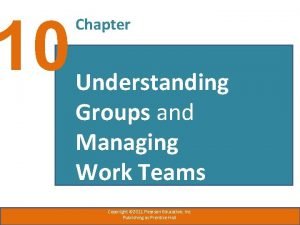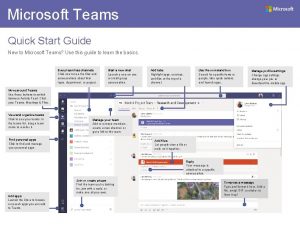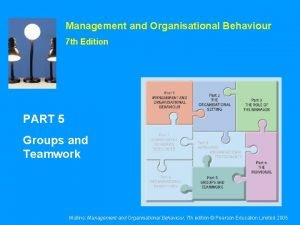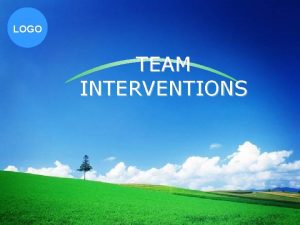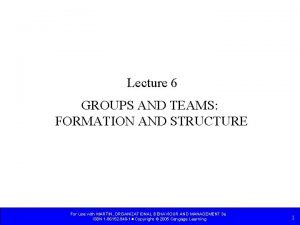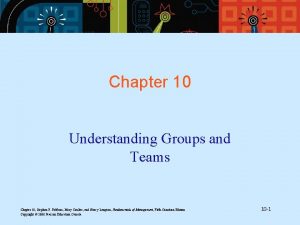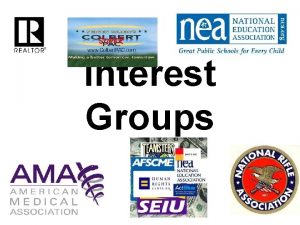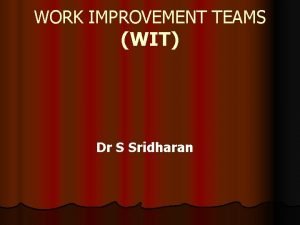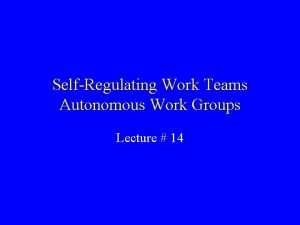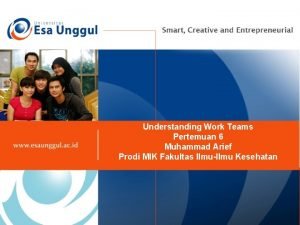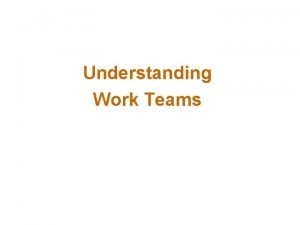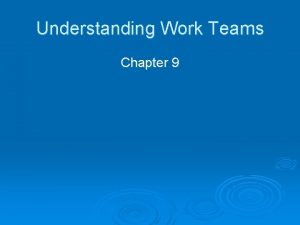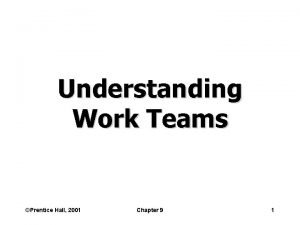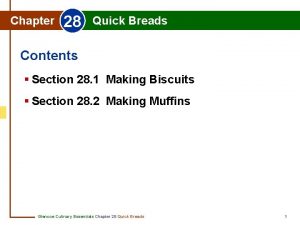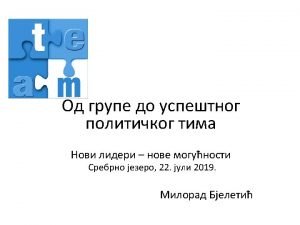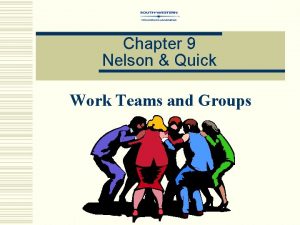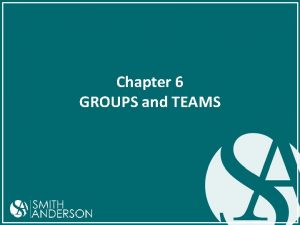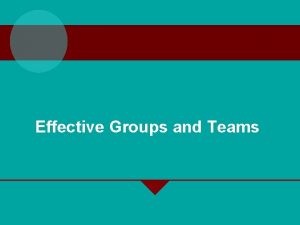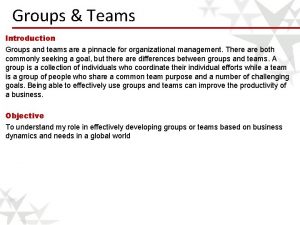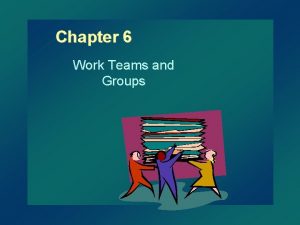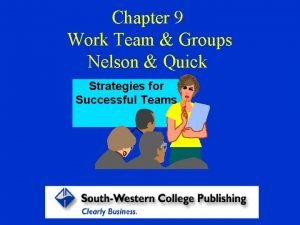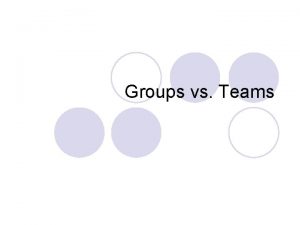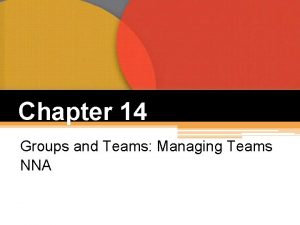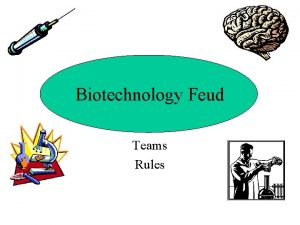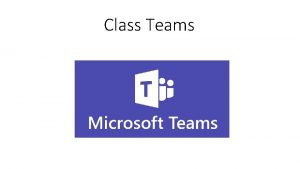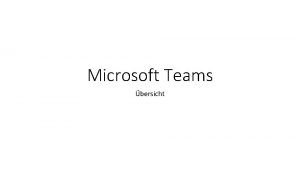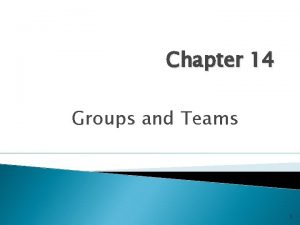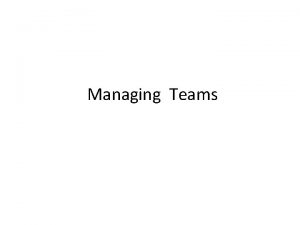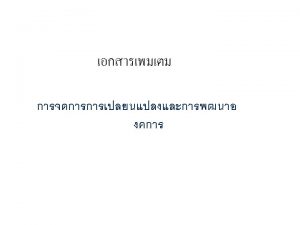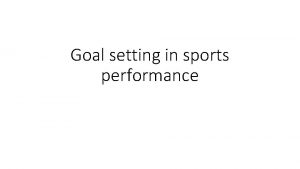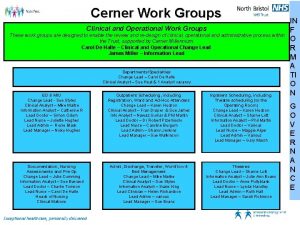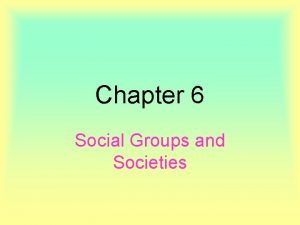Chapter 9 Nelson Quick Work Teams and Groups

























- Slides: 25

Chapter 9 Nelson & Quick Work Teams and Groups

Groups & Teams Group - two or more people with common interests, objectives, and continuing interaction Work Team - a group of people with complementary skills who are committed to a common mission, performance goals, and approach for which they hold themselves mutually accountable

Characteristics of a Well-Functioning, Effective Group Relaxed, comfortable, informal atmosphere Task well understood & accepted Members listen well & participate People express feelings & ideas

Characteristics of a Well-Functioning, Effective Group Conflict & disagreement center around ideas or methods Group aware of its operation & function Consensus decision making Clear assignments made & accepted

Group Behavior Norms of Behavior - the standards that a work group uses to evaluate the behavior of its members Group Cohesion - the “interpersonal glue” that makes members of a group stick together Social Loafing - the failure of a group member to contribute personal time, effort, thoughts, or other resources to the group Loss of Individuality - a social process in which individual group members lose self-awareness & its accompanying sense of accountability, inhibition, and responsibility for individual behavior

Group Formation Formal Groups – official or assigned groups gathered to perform various tasks n need ethnic, gender, cultural, and interpersonal diversity n need professional and geographical diversity Informal Groups unofficial or emergent groups that evolve in the work setting to gratify a variety of member needs not met by formal groups

Stages of Group Formation Mutual acceptance Decision making Motivation and commitment Control and sanctions Emphasis on interpersonal concern and awareness Emphasis on task planning, authority and influence Emphasis on task accomplishment, leadership and performance Emphasis on rewards and punishment

Mature Group Characteristics Purpose and Mission w May be assigned or may emerge from the group w Group often questions, reexamines, and modifies mission and purpose w Mission converted into specific agenda, clear goals, and a set of critical success factors

Mature Group Characteristics Behavioral Norms - well-understood standards of behavior within a group Formal & written Ground rules for meetings Informal but well understood Intragroup socializing Dress codes Productivity Norms – may be consistent or inconsistent, supportive or unsupportive of organization’s productivity standards

Mature Group Characteristics Group Cohesion - interpersonal attraction binding group members together w Enables groups to exercise effective control over the members w Groups with high cohesiveness n demonstrate lower tension & anxiety n demonstrate less variation in productivity n demonstrate better member satisfaction, commitment, & communication

Cohesiveness & Work-Related Tension Group cohesiveness from low to high “Does your work ever make you jumpy or nervous? ” Low score = high tension 7 16 52 65 57 Number of groups 19 12 From S. E. Seashore, Group Cohesiveness in the Industrial Work Force, 1954. Research conducted by Stanley E. Seashore at the Institute for Social Research, University of Michigan. Reprinted by permission.

Mature Group Characteristics Status Structure - the set of authority & task relations among a group’s members w Hierarchical or egalitarian w Often leadership is shared Diversity Styles Data/Info Contributor Mission Collaborator Facilitator Communicator Devil’s advocate Challenger

Team Task Functions - those activities directly related to the effective completion of the team’s work Give information Initiate activities Test ideas Seek information Summarize ideas Elaborate concepts Coordinate activities Evaluate effectiveness Diagnose problems

Team Task Functions Maintenance Functions - those activities essential to the effective, satisfying interpersonal relationships within a team or group Follow others’ lead Support others Harmonize conflict Set standards Test group decisions Express member feelings Gatekeep communication Test consensus Reduce tension

Why Teams? w Good when performing complicated, complex, inter -related and/or more voluminous work than one person can handle w Good when knowledge, talent, skills, & abilities are dispersed across organizational members w Empowerment and collaboration; not power and competition w Basis for total quality efforts

New vs. Old Team Environments New Team Environment Old Work Environment Person generates initiatives Person follows orders Team charts its own steps Manager charts course Right to think for oneself. People rock boat; work together People conformed to manager’s direction. No one rocked the boat. People cooperate using thoughts and feelings; direct talk People cooperated by suppressing thoughts and feelings; wanted to get along SOURCE: Managing in the New Team Environment, by Hirschhorn, © 1991. Reprinted by permission of Prentice-Hall, Inc. , Upper Saddle River, N. J.

Quality Circles & Teams Quality Team - a team that is part of an organization’s structure & is empowered to act on its decisions regarding product & quality service Quality Circles (QC) - a small group of employees who work voluntarily on company time, typically one hour per week, to address work-related problems QC’s deal with substantive issues n Do not require final decision authority n QC’s need periodic reenergizing

Social Benefits of Teams Psychological Intimacy emotional & psychological closeness to other team or group members Integrated Intimacy closeness achieved through tasks & activities

Foundations for Empowerment An attribute of a person or of an organization’s culture Preparation & careful planning focuses empowered employees Encourages participation Solve specific and global problems

Empowerment Skills Competence Skills Cooperative and Helping Behaviors Process Skills Selfmanagement or Team skills Communication Skills

Self-Managed Teams Self Managed Teams - teams that make decisions that were once reserved for managers How does an organization capitalize on the advantages and avoid the risks of self managed teams?

Upper Echelons: Teams at the Top

Executive Tenure & Organizational Performance Organizational performance relative to the industry average High Low 1 7 CEO tenure (years) 14 Source: D. Hambrick, The Seasons of an Executive’s Tenure, keynote address, the Sixth Annual Texas Conference on Organizations, Lago Vista, Texas, April, 1991.

Multicultural Teams Multicultural groups represent three or more ethnic backgrounds. Diversity may increase uncertainty, complexity, & inherent confusion in group processes. Culturally diverse groups may generate more & better ideas & limit groupthink.

Triangle for Managing in the New Team Environment Manager Team Individuals L. Hirschhorn, Managing in the New Team Environment, (pages 13/14). Copyright© 1991 Addison-Wesley Publishing Company, Inc. Reprinted by permission of Addison Wesley Longman.
 Understanding groups and teams
Understanding groups and teams Teams quick start guide
Teams quick start guide Ms teams quick start guide
Ms teams quick start guide Group and team difference
Group and team difference Groups and teams difference
Groups and teams difference Groups and teams difference
Groups and teams difference Understanding groups and teams
Understanding groups and teams Understanding groups and teams
Understanding groups and teams Quick find algorithm
Quick find algorithm The fan blade is speeding up. what are the signs of
The fan blade is speeding up. what are the signs of How are ethnic groups and religious groups related
How are ethnic groups and religious groups related Chapter 9 section 1 the nature of interest groups
Chapter 9 section 1 the nature of interest groups Chapter 10 motivating and satisfying employees and teams
Chapter 10 motivating and satisfying employees and teams Is the individual internal process that energizes directs
Is the individual internal process that energizes directs Energy conservation quick check
Energy conservation quick check Section 4 review physical science
Section 4 review physical science Work improvement team
Work improvement team Autonomous work groups
Autonomous work groups Understanding work teams
Understanding work teams Cross functional team
Cross functional team Understanding work teams
Understanding work teams Understanding work teams
Understanding work teams Quick breads and batters chapter 41 answers
Quick breads and batters chapter 41 answers Nelson science perspectives 9 chapter 12
Nelson science perspectives 9 chapter 12 Workgroups are characterized by
Workgroups are characterized by Remedial social work
Remedial social work
